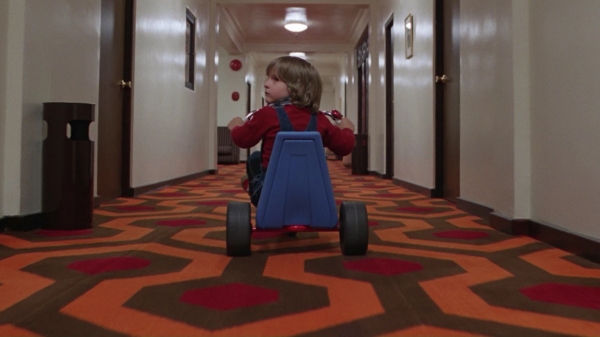“Room 237″ opens Friday at Sundance Cinemas. Not rated, 1:38, 3.5 stars out of 4
You know when “Room 237” starts getting really scary? When the people in the film start making sense.
Rodney Ascher’s playful and engrossing documentary looks at another film, Stanley Kubrick’s “The Shining,” through the perspectives of five absolutely obsessed fans. And I don’t mean obsessed as in “watches it every Thanksgiving” or “has the poster framed in their rec room.” I mean obsessed as in doing frame-by-frame analyses of the film, looking for hidden objects, continuity errors and other Easter Eggs they believe Kubrick left there to support their theories.
One critic insists that “The Shining” is really Kubrick’s veiled confession that he was involved in faking the footage of the Apollo moon landing. Why else would the sign “Room N. 237” be so prominent in one shot, if it wasn’t an anagram of “moon”? (Plus an ‘R”, I grant you.) Another sees cans of food in the hotel kitchen bearing the likeness of a Native American chief, a clue that Kubrick has really made a movie about the betrayal of Native Americans.
A repeated phrase throughout the film is a variation on “Most people wouldn’t catch this, but . . .” and goes on to make some connection that absolutely nobody would see (such as, supposedly, Kubrick’s face superimposed in the clouds during the opening credits). The obsessives always assume that they have some secret connection to the film that allows them to see what’s really going on. An interest in Holocaust history, for example, makes one uniquely qualified to see the Holocaust references in the film, such as a German typewriter. The thought never occurs to them that they are imposing their own interpretations onto the film. If these are conspiracy theories, it’s a conspiracy of two people — Kubrick and the “enlightened” obsessive.
We never see these theorizers; instead, we hear their voices throughout the film, which visually is made entirely of clips from “The Shining” and occasionally other movies. Fitting, of course, because these obsessives can’t see beyond the frame of the film. As one puts it late in the movie, they’re as trapped in the Overlook Hotel as much as Jack Torrance, doomed to roam around and around its halls, looking for patterns, looking for answers. When another fan talks about playing “The Shining” simultaneously backwards and forwards, one image imposed upon the other, it’s a perfect visual metaphor, turning the film into an endless Moebius strip to get lost in, with no entrances and no exits.
But then somebody actually makes a good point, and it jars you. For example, one woman points out that, in the scene where Jack is talking to the hotel manager in his office, bright sunlight is pouring through the window. However, if you examine the layout of the hotel, that office should be right in the center of the building, with no access to an outside window. So we may scoff at these outlandish theories, but a healthy dose of respect should go along with that; they may be seeing a lot that isn’t there, but they’re seeing some things that are, too.
So where is the light coming from? Was it a just a continuity goof-up, or was Kubrick making some sort of secret metaphor? Or, more likely, did he just think it looked right for the shot, and never a million years expected that diehard fans would be studying his film so closely?
Either way, “Room 237” is both kind of an affectionately cracked ode to filmophilia as well as a warning sign as to its perils. And it’s also the greatest recommendation ever to go watch “The Shining” again.
